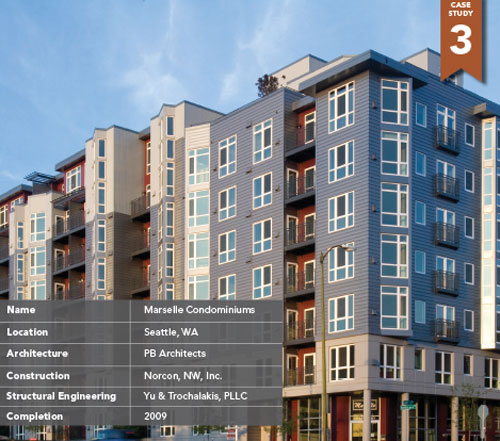Mass Timber and Wood Framing
| Seattle Hybrid: Wood Platform Framing and a Concrete Podium |
||
The Marselle is a hybrid wood and concrete structure consisting of five stories of wood-platform framing plus a wood mezzanine and a six-story concrete podium, of which, two stories are above ground. The combination of “five and one-half over two” made Marselle the tallest modern wood-frame structure in Seattle. Marselle's main distinction lies in the way wood framing was used to maximize the value of the finished space. Two key code requirements allowed that to happen. The City of Seattle's 2003 Building Code (SBC), under which the Marselle was built, was based on the 2003 International Building Code (IBC). Under the 2003 IBC, mezzanines were limited to 33 percent of the floor area beneath. However, SBC allowed five stories of wood construction over two stories of Type I construction plus 50 percent for a mezzanine. Mezzanine levels are not considered floors. Under the SBC, Type V-A construction allowed a fully sprinklered 70-foot maximum height for five stories while Type III-A allowed a fully sprinklered 85-foot maximum height for five stories. Zoning regulations allowed a maximum height of 85 feet. Therefore, the design team took advantage of Type III-A construction by adding a mezzanine level on top of the allowed five-story structure, to fill in the building envelope to the 85-foot maximum zoning height allowed. The other criteria concerned construction type. According to architect Michael Shreve with PB Architects, “under the 2003 SBC, section 504.2, the allowable height for buildings of Type III-A construction in Group R-2 could be increased to five floors of wood-frame construction above two stories of Type I concrete construction and an 85-foot maximum height. The two floors of concrete construction were required to be Type I construction with a three-hour horizontal fire rating separating the wood construction from the concrete construction.” “Once built, the top level units would have water views of Seattle's Lake Union,” explained structural engineer Panos Trochalakis, P.E., S.E., principal with Yu & Trochalakis, PLLC. “For obvious reasons, the developer wanted to take advantage of that.” The extra half-story mezzanine added about $250,000 to the construction cost of the building, but the architect and builder estimated that the added height and space increased the value of the complex by $1 million and afforded revenue-generating views on the top floors. Attention was devoted to maximizing the strength and durability of the wood members, with architects designing for potential shrinkage. As is typical with wood-framed podium structures, Marselle's contractors used a continuous rod tie-down system with a shrinkage compensation device to limit deflection and avoid wall separation due to wood shrinkage under wind and seismic forces. They also included an expansion joint in the cladding; were careful to specify proper panel spacing in the exterior wall sheathing; and included a provision in the mechanical system to allow for movement. The use of wood also had a positive impact on schedule and budget factors, with pre-panelized walls enabling a speed of construction that made a big difference. The panels, which ranged from 4 to 20 feet long, were pre-assembled by a local framer in an off-site warehouse, and then quickly and easily lifted into place at the job site by crane. “If you can install the walls on a building the size of Marselle in less than two weeks per floor, then you lower construction costs significantly,” Trochalakis says. “Lower construction costs were the number one reason to use wood. Wood-frame construction is virtually impossible to beat in terms of cost.”10 |










